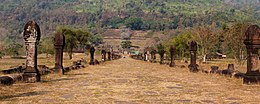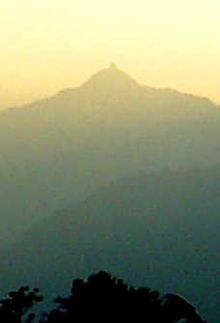Vat Phou
UNESCO World Heritage Site in Champasak, Laos From Wikipedia, the free encyclopedia
UNESCO World Heritage Site in Champasak, Laos From Wikipedia, the free encyclopedia
Vat Phou (or Vat Phu; Lao: ວັດພູ [wāt pʰúː] temple-mountain) is a ruined Khmer-Hindu temple complex in southern Laos and one of the oldest places of worship in Southeast Asia. It is at the base of mount Phou Khao, some 6 kilometres (3.7 mi) from the Mekong in Champasak province.
| UNESCO World Heritage Site | |
|---|---|
 Causeway, looking towards the sanctuary | |
| Location | Champasak Province, Laos |
| Criteria | Cultural: (iii)(iv)(vi) |
| Reference | 481 |
| Inscription | 2001 (25th Session) |
| Area | 39,000 ha (96,000 acres) |
| Coordinates | 14°50′54″N 105°49′20″E |
There was a sanctuary on the site, centred on a sacred spring and an offering place for a mighty tutelary sprit dating back to pre-historic times. The first megalithic stone structures had been built probably as early as the second century BCE, consisting of two stone cells, a carving of a crocodile, serpent stairs, and several offering platforms.[1] One of the first pre-Angkor brick buildings onsite was erected in the early 7th century and became the focus of all consequent building activities.[1] Most of the other surviving buildings date from the Angkor period, in the 11th—13th centuries.


Vat Phou was initially associated with the city of Shrestapura,[2]: 66 which lay on the bank of the Mekong directly east of Lingaparvata Mountain (now called Phou Khao). By the latter part of the fifth century, the city was the capital of a kingdom that texts and inscriptions connect with the Chenla Kingdom and Champa. The first structure on the mountain was constructed around this time. The mountain gained spiritual importance from the lingam-shaped protuberance on its summit. The mountain itself was, therefore, considered the home of Shiva, and the river as representing the ocean or the Ganges.
Vat Phou was a part of the Khmer Empire centred on Angkor to the southwest, at least as early as the reign of Yasovarman I in the early 10th century. Shrestapura was superseded by a new city in the Angkorian period, directly south of the temple. In the later period, the original buildings were replaced, re-using some of the stone blocks; the temple now seen was built primarily during the Koh Ker and Baphuon periods of the 11th century. Minor changes were made during the following two centuries, before the temple, like most in the empire, was converted to Theravada Buddhist use.
This continued after the area came under control of the Lao, and a festival is held on the site each February. Little restoration work has been done, other than the restoration of boundary posts along the path. Vat Phou was designated a World Heritage Site in 2001.[3]

Like most Khmer temples, Vat Phou is oriented towards the east, although the axis faces eight degrees south of due east, being determined primarily by the orientation of the mountain and the river. Including the barays (reservoirs), it stretches 1.4 kilometres (0.87 mi) east from the source of the spring, at the base of a cliff 100 metres (330 ft) up the hill. 6 kilometres (3.7 mi) east of the temple, on the west bank of the Mekong, lay the city, while a road south from the temple itself led to other temples and ultimately to the city of Angkor.

Approached from the city (of which little remains), the first part of the temple reached is a series of barays. Only one now contains water, the 600 by 200 m middle baray which lies directly along the temple's axis; there were reservoirs north and south of this, and a further pair on each side of the causeway between the middle baray and the palaces.

The two palaces stand on a terrace on either side of the axis. They are known as the north and south palaces or, without any evidence, the men's and women's palaces (the term "palace" is a mere convention and their purpose is unknown). Each consisted of a rectangular courtyard with a corridor and entrance on the side towards the axis, and false doors at the east and west ends. The courtyards of both buildings have laterite walls. The walls of the northern palace's corridor are laterite, while those of the southern palace are sandstone. The northern building is now in better condition. The palaces are notable chiefly for their pediments and lintels, which are in the early Angkor Wat style.


The next terrace has a small shrine to Nandi (Shiva's mount) to the south, in poor condition. The road connecting Vat Phou to Angkor ran south from this temple. Continuing west, successive staircases lead up further terraces; between them stands a dvarapala which has come to be worshiped as king Kammatha, mythical builder of the temple. On the narrow next terrace are the remains of six small shrines destroyed by treasure-hunters.

The path culminates in seven sandstone tiers which rise to the upper terrace and central sanctuary. The sanctuary is in two parts. The front section, of sandstone, is now occupied by four Buddha images, while the brick rear part, which formerly contained the central lingam, is empty.
The entire roof is missing, although a makeshift covering has been added to the front. Water from the spring which emerges from the cliff about 60 m southwest of the sanctuary was channeled along stone aqueducts into the rear chamber, continuously bathing the lingam. The sanctuary is later than the north and south palaces, belonging to the Baphuon period of the later 11th century. The east side has three doorways: from south to north, their pediments show Krishna defeating the nāga Kaliya; Indra riding Airavata; and Vishnu riding Garuda. The east wall bears dvarapalas and devatas. Entrances to the south and north have inner and outer lintels, including one to the south of Krishna ripping Kamsa apart.

Other features of the area are a library, in poor condition, south of the sanctuary, and a relief of the Trimurti to the northwest. There are other carvings further north: a Buddha footprint on the cliff face and boulders shaped to resemble elephants and a crocodile. The crocodile stone has acquired some notoriety as being possibly the site of an annual human sacrifice described in a sixth-century Chinese text. The identification is lent some plausibility by the similarity of the crocodile's dimensions to those of a human.
The most remarkable feature of the Vat Phou complex is that it shows the development of the Khmer stone architecture from its earliest beginnings until the 13th century.
After the first scientific description on the late 19th and early 20th century there was little scientific activity at the site until the early 1990s. With the Lao-UNESCO projects starting in 1987 and the designation as UNESCO World Heritage Site in 2001 archeologic and conservation activities increased heavily. Examples of the most recent conservation projects are:[4]
Today the site is open to the public for religious activities and tourist visits. Hours are 08:00–18:00, and the entrance fee is 50,000 LAK for foreigners and 20,000 LAK for locals.[5]
The site features a museum which houses artifacts of the temple complex of several centuries, such as statues of Shiva, Vishnu and Nandin, as well as Buddhist statues.[6] The museum building has been limited to a specific size to minimize altering the underground site and the view.[7]
Seamless Wikipedia browsing. On steroids.
Every time you click a link to Wikipedia, Wiktionary or Wikiquote in your browser's search results, it will show the modern Wikiwand interface.
Wikiwand extension is a five stars, simple, with minimum permission required to keep your browsing private, safe and transparent.